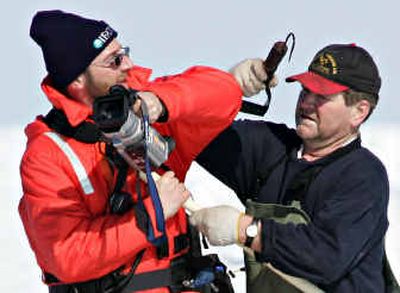Activists confront seal pup hunters

CHARLOTTETOWN, Prince Edward Island – Protesters alighting from helicopters to try to stop a seal hunt scuffled Friday with sealers who fired warning shots – sending the protesters scurrying back to the aircraft.
Canada’s harp seal hunt, the target of protests since the 1960s, began this week when thousands of sealers armed with clubs, rifles and spears headed for the ice floes off eastern Canada for the world’s largest such hunt.
Canada says the hunt brings $16.5 million in badly needed income to its coastal communities, primarily from pelt sales to Norway, Denmark and China. Animal activists condemn the hunt as barbaric. The United States bans imports of seal products.
Protesters arrived by helicopters Friday, and a sealer approached swinging a 12-foot stick with a hook. At one point, a snowmobile carrying two sealers hurtled toward the activists but swung away at the last moment.
The two groups started shoving each other, and when several shots were fired into the air by a sealer aboard a boat, the protesters retreated to their helicopters. Protesters included members of the International Fund for Animal Welfare.
No one was hurt.
The protesters are required to keep at least 10 yards from the sealers.
Michel Therien, a spokesman for Canada’s Fisheries and Oceans Department, said three protesters were arrested on Thursday for violating the distance regulations.
Paul Watson, captain of the protest ship Farley Mowat, said he saw one sealer attack a member of his crew on the ice Thursday. The sealer said he was just defending himself.
The seal hunt begins about two weeks after the seal pups are born and before their fur changes from white to gray. Animal rights activists say the pups are clubbed to death and often skinned alive, but sealers and government officials insist the pups die instantly, under strict guidelines.
Aboriginal and Inuit subsistence and commercial hunters begin the kill Nov. 15 in Canada’s vast expanse of frozen Northern waters, which reach from the Yukon Territories near Alaska through the Arctic Ocean and down into the North Atlantic off Labrador.
The spring leg of the commercial hunt starts in the Gulf of St. Lawrence and moves to the Front, an arc of the Atlantic Ocean sweeping out 30 to 40 miles from Newfoundland. Hunters were expected to kill more than 300,000 seals by May 15.
Canada’s Department of Fisheries and Oceans says the country’s seal population is “healthy and abundant” and notes that there are an estimated 5 million harp seals, nearly the highest level ever recorded and almost triple what it was in the 1970s.